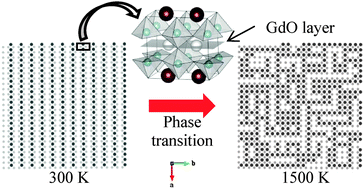The configurations of oxygen ions and vacancies at various oxygen stoichiometries and temperatures in double perovskite oxides (GdBaCo2O5+δ, 0 ≤ δ ≤ 1) have been determined by density functional theory (DFT) combined with Monte Carlo (MC) simulations. The MC simulations confirmed the existence of a superstructure at δ = 0.5, showing alternating linear ordering of oxygen ions and vacancies along the b-axis in the GdO layer. This structure is identical to that reported experimentally. Increasing the temperature up to 1200 K induces a phase transition manifested in the breaking of the oxygen/vacancy arrangement at around δ = 0.5. In the high-temperature phase, vacancies are distributed in the GdO and CoO2 layers, whereas there are no vacancies in the BaO layer. In addition, the characteristic linear arrangement is partly preserved even in the disordered high-temperature phase. Consequently, oxygen ions can migrate between the GdO and CoO2 layers, as reported in previous classical molecular dynamics simulation studies.

You have access to this article
 Please wait while we load your content...
Something went wrong. Try again?
Please wait while we load your content...
Something went wrong. Try again?


 Please wait while we load your content...
Please wait while we load your content...